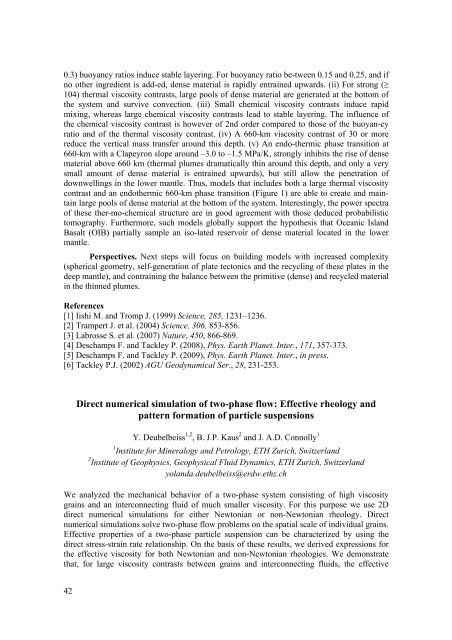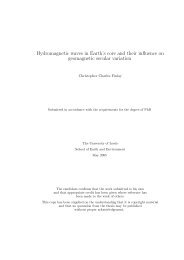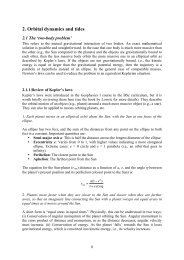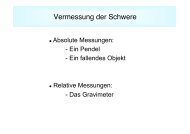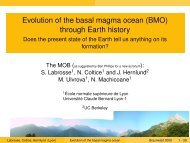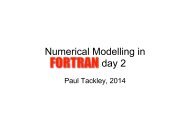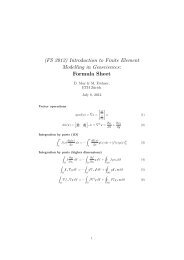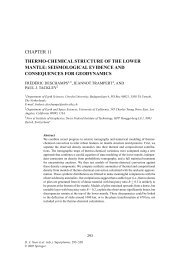here - ETH Zürich
here - ETH Zürich
here - ETH Zürich
- No tags were found...
Create successful ePaper yourself
Turn your PDF publications into a flip-book with our unique Google optimized e-Paper software.
0.3) buoyancy ratios induce stable layering. For buoyancy ratio be-tween 0.15 and 0.25, and ifno other ingredient is add-ed, dense material is rapidly entrained upwards. (ii) For strong ($104) thermal viscosity contrasts, large pools of dense material are generated at the bottom ofthe system and survive convection. (iii) Small chemical viscosity contrasts induce rapidmixing, w<strong>here</strong>as large chemical viscosity contrasts lead to stable layering. The influence ofthe chemical viscosity contrast is however of 2nd order compared to those of the buoyan-cyratio and of the thermal viscosity contrast. (iv) A 660-km viscosity contrast of 30 or morereduce the vertical mass transfer around this depth. (v) An endo-thermic phase transition at660-km with a Clapeyron slope around –3.0 to –1.5 MPa/K, strongly inhibits the rise of densematerial above 660 km (thermal plumes dramatically thin around this depth, and only a verysmall amount of dense material is entrained upwards), but still allow the penetration ofdownwellings in the lower mantle. Thus, models that includes both a large thermal viscositycontrast and an endothermic 660-km phase transition (Figure 1) are able to create and maintainlarge pools of dense material at the bottom of the system. Interestingly, the power spectraof these ther-mo-chemical structure are in good agreement with those deduced probabilistictomography. Furthermore, such models globally support the hypothesis that Oceanic IslandBasalt (OIB) partially sample an iso-lated reservoir of dense material located in the lowermantle.Perspectives. Next steps will focus on building models with increased complexity(spherical geometry, self-generation of plate tectonics and the recycling of these plates in thedeep mantle), and contraining the balance between the primitive (dense) and recycled materialin the thinned plumes.References[1] Iishi M. and Tromp J. (1999) Science, 285, 1231–1236.[2] Trampert J. et al. (2004) Science, 306, 853-856.[3] Labrosse S. et al. (2007) Nature, 450, 866-869.[4] Deschamps F. and Tackley P. (2008), Phys. Earth Planet. Inter., 171, 357-373.[5] Deschamps F. and Tackley P. (2009), Phys. Earth Planet. Inter., in press.[6] Tackley P.J. (2002) AGU Geodynamical Ser., 28, 231-253.Direct numerical simulation of two-phase flow: Effective rheology andpattern formation of particle suspensionsY. Deubelbeiss 1,2 , B. J.P. Kaus 2 and J. A.D. Connolly 11 Institute for Mineralogy and Petrology, <strong>ETH</strong> Zurich, Switzerland2 Institute of Geophysics, Geophysical Fluid Dynamics, <strong>ETH</strong> Zurich, Switzerlandyolanda.deubelbeiss@erdw.ethz.chWe analyzed the mechanical behavior of a two-phase system consisting of high viscositygrains and an interconnecting fluid of much smaller viscosity. For this purpose we use 2Ddirect numerical simulations for either Newtonian or non-Newtonian rheology. Directnumerical simulations solve two-phase flow problems on the spatial scale of individual grains.Effective properties of a two-phase particle suspension can be characterized by using thedirect stress-strain rate relationship. On the basis of these results, we derived expressions forthe effective viscosity for both Newtonian and non-Newtonian rheologies. We demonstratethat, for large viscosity contrasts between grains and interconnecting fluids, the effective42


